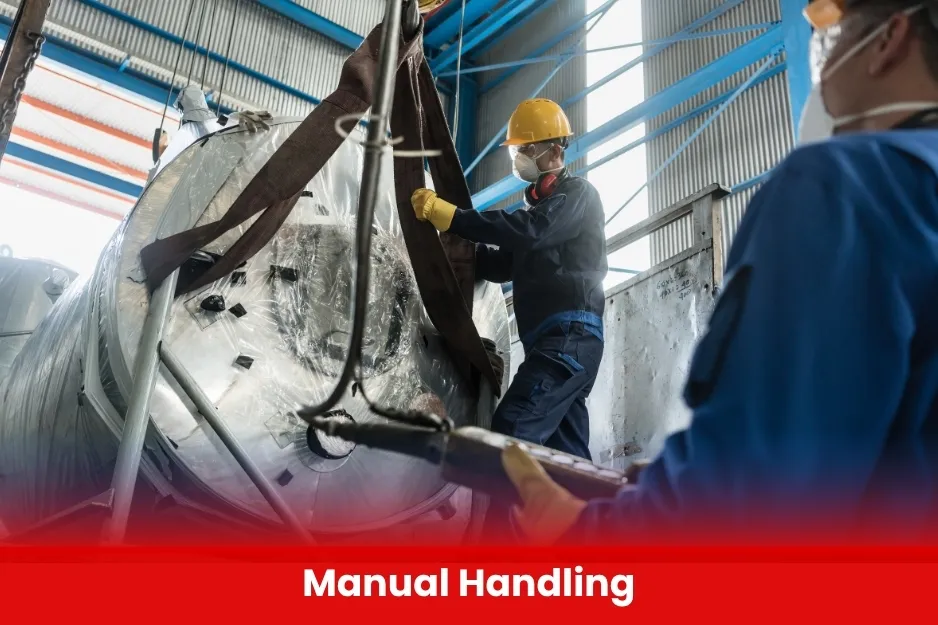Manual Handling
At Buraaq UK, we recognize that manual handling tasks—such as lifting, carrying, pushing, or pulling objects—are common in many of our work activities. While often routine, these tasks can pose significant risks if not performed correctly, leading to musculoskeletal injuries and lost productivity. Our commitment is to ensure that all manual handling activities are conducted safely, with risks minimized through appropriate training, risk assessments, and use of equipment where necessary. This approach aligns with the UK’s Manual Handling Operations Regulations 1992 and supports our overall health and safety objectives.

Aim of Manual Handling
To minimize the risk of injury related to manual handling activities by promoting safe lifting techniques, providing appropriate training, and encouraging the use of mechanical aids and team support, thereby ensuring a safer working environment for all employees.
Course Overview
Manual Handling
- All Employees Involved in Manual Handling Tasks
- Employees who regularly or occasionally lift, carry, push, or pull loads as part of their job.
- Includes warehouse staff, delivery personnel, office staff handling supplies, maintenance teams, and others.
- New Starters, Interns, and Trainees
- Must receive manual handling training during induction if their role involves handling tasks.
- Supervisors and Managers
- Responsible for ensuring that their teams follow safe manual handling practices.
- Encouraged to attend training to understand risk assessment and control measures.
- Contractors and Subcontractors
- If required to perform manual handling on Buraaq UK sites, must comply with manual handling safety policies.
- May be required to attend site-specific training or briefings.
- Volunteers and Temporary Staff
- If involved in handling tasks, should receive appropriate manual handling trai
| Course Code | Curriculum Title | Credit | DLH |
|---|---|---|---|
| BUK1737- 1 | Introduction to Manual Handling | 2 | 10 |
| BUK1737-2 | Anatomy and Injury Prevention | 2 | 10 |
| BUK1737-3 | Risk Assessment and Hazard Identification | 2 | 10 |
| BUK1737-4 | Safe Lifting Techniques | 2 | 10 |
| BUK1737-5 | Use of Mechanical Aids and Equipment | 2 | 10 |
| BUK1737-6 | Team Lifting and Communication | 2 | 10 |
Learning Objectives
Introduction to Manual Handling
- Understanding manual handling and its risks
- Overview of relevant legislation (Manual Handling Operations Regulations 1992)
- Importance of safe manual handling in the workplace
Anatomy and Injury Prevention
- Basics of musculoskeletal system
- Common injuries from poor manual handling
- Signs and symptoms of strain or injury
Risk Assessment and Hazard Identification
- Identifying hazards related to manual handling tasks
- Assessing risk factors: load, environment, individual capability
- Control measures and safe work methods
Safe Lifting Techniques
- Step-by-step correct lifting methods
- Use of body mechanics to reduce injury risk
- When and how to ask for assistance
Use of Mechanical Aids and Equipment
- Types of aids: trolleys, hoists, pallet trucks, etc.
- Correct operation and maintenance of equipment
- Benefits of using aids to reduce manual effort
Team Lifting and Communication
- Coordinating lifts with others
- Clear communication and roles during team handling
Practical Exercises and Demonstrations
- Hands-on practice of lifting techniques
- Real-life scenarios and problem-solving
- Employees Performing Manual Handling Tasks
- New Employees, Interns, and Trainees
- Supervisors and Managers
- Contractors and Subcontractors
- Temporary Staff and Volunteers
- All Modules within this qualification are assessed internally by the approved training Centre and externally verified by BURRAQ UK. The program uses a criterion-referenced assessment approach to ensure that learners successfully meet all required learning outcomes.
- A Pass in any unit is granted only when the learner submits valid, reliable, and authentic evidence that demonstrates achievement of the assessment criteria. The Assessor is responsible for reviewing this evidence and confirming that the learner has attained the expected standard.
